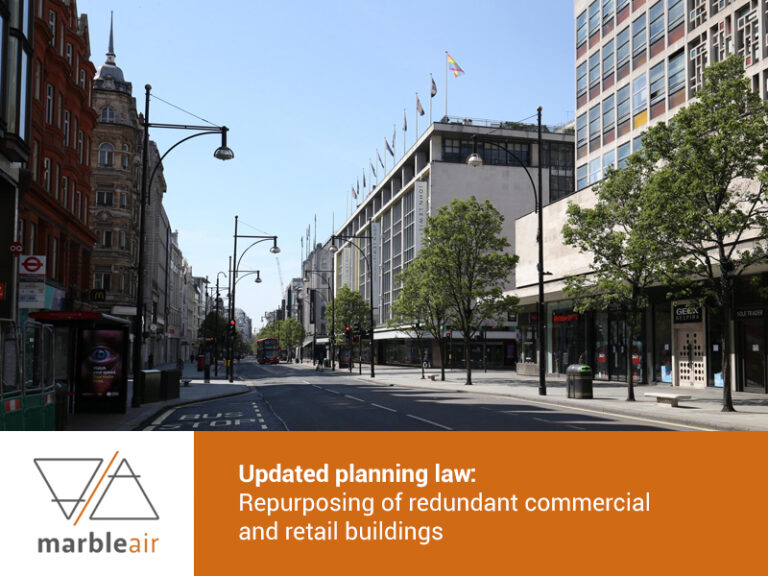
Updated Planning Law: Repurposing of Redundant Commercial and Retail Buildings
The UK government has recently introduced changes to planning law, which allows for redundant commercial and retail buildings to be repurposed. Further details are below:
Permitted Development Rights for Additional Storeys to Dwellinghouses
The Town and County Planning (General Permitted Development) (England) (Amendment) (No. 2) Order 2020 will confer permanent permitted development rights to allow existing houses to be extended by way of the addition of up to 2 storeys. The rights apply to existing houses which are detached, semi-detached or in a terrace. They are subject to a maximum height limit of 18m, and where the house is in a terrace its height cannot be more than 3.5m higher than the next tallest house in the terrace. The rights only apply to houses built between 1 July 1948 and 28 October 2018 and do not apply in Conservation Areas. There is a requirement to obtain prior approval in relation to the impact on the amenity of neighbouring premises, the external appearance, and the impacts a taller building may have on air traffic and defence assets.
Permitted Development Rights for Additional Storeys to Create Dwellings
The above Order will also introduce a new Class AA and AB to Part 20 of the General Permitted Development Order to allow the construction of up to 2 additional storeys on free standing blocks and on buildings in a terrace that are in certain commercial uses (including A1, A2, A3 and B1(a)), and in mixed uses with an element of housing, to create additional self-contained homes. The rights are subject to a maximum height limit of 30m for detached buildings and 18m for terraces.
A new Class AC and AD to Part 20 to the General Permitted Development Order will allow up to 2 additional storeys to be constructed on existing houses which are detached or in a terrace to create new self-contained homes. The rights are subject to a maximum height limit for the newly extended building of 18m and it cannot be more than 3.5m higher than the next tallest house in the terrace.
These rights apply to houses and buildings built between 1 July 1948 and 5 March 2018 and they have to have been in one of the relevant uses or mixed uses on 5 March 2018. The rights will not apply in Conservation Areas or to listed buildings or scheduled monuments. There is a requirement to obtain prior approval in relation to the transport and highway impacts of the development, contamination and flooding risks, the external appearance, impact on amenity, the provision of adequate natural light in all habitable rooms of the new homes, noise impact from existing commercial uses, impact on surrounding businesses and the impact on air traffic and defence assets.
Permitted Development Rights for Demolition and Rebuild for Residential Use
The Town and County Planning (General Permitted Development) (England) (Amendment) (No. 3) Order 2020 will introduce a new Class ZA to the General Permitted Development Order conferring permanent permitted development rights to allow for the demolition of vacant and redundant free-standing buildings that fell within use class B1 and C3 on 12 March 2020, and their replacement with residential development. The rights apply to purpose-built residential blocks of flats only, and therefore do not apply to terraced buildings, detached dwellings or mixed-use buildings. The rights will also only apply to buildings constructed prior to 1 January 1990 that have been entirely vacant for at least 6 months prior to the application for prior approval. The development, consisting of both demolition and replacement build, must be completed within three years of the date of the grant of prior approval.
There are various limits placed on the scale of the development permitted, including that it must be within the footprint of the original building with a footprint of up to 1,000 sq m and with a maximum height of 18m. There is a requirement to obtain prior approval in relation to the transport and highway impacts of the development, contamination and flooding risks, the impact of noise from other premises on the future residents, design and external appearance of the new building, the adequacy of natural light in all habitable rooms of each new dwelling, the impact of the introduction of residential use into an area, and the impact of the development on the amenity of the new building and of neighbouring premises, impacts of noise from commercial premises, the impact on surrounding businesses, impact on heritage and archaeology, the method of demolition, plans for landscaping and the impact on air traffic and defence. The rights will not apply in Conservation Areas or to listed buildings or scheduled monuments.
Changes to Use Classes Order
The Town and Country Planning (Use Classes) (Amendment) (England) Regulations 2020 will create a new broad “commercial, business and service” use class (Class E) which incorporates the previous shops (A1), financial and professional services (A2), restaurants and cafes (A3) and offices (B1) use class. Uses such as gyms, nurseries and health centres previously within use class D1 and D2, and other uses which are suitable for a town centre area, are also included in the new use class. A change of use within a single use class is not development for the purposes of the Town and County Planning Act 1990, and therefore the use of a building within this new use class will be able to change to another use, or mix of uses, within the use class without the need for planning permission. The Government’s hope is that, by bringing these uses together and allowing movement between them, they will give businesses greater freedom to adapt to changing circumstances and to respond more quickly to the needs of their communities.
The Regulations will also create a new “Learning and non-residential institutions” (F1) incorporating those uses within the former D1 Non-residential institutions use class, such as schools, libraries and art galleries. There will also be a “Local community” (F2) use class incorporating those uses from the former D2 use class which provide for group activities of a more physical nature such as swimming pools, skating rinks and areas for outdoor sports as well as shops servicing the essential needs of local communities. The former A4 drinking establishments and A5 hot food take away use classes have been removed and these uses are now sui generis, together with cinemas, concert, dance and bingo halls.
The new permitted development rights will come into effect on 31st August 2020 and the changes to the Use Classes Order will come into effect on 1st September 2020. The changes undoubtedly give rise to new development opportunities, although the scope of them will be curtailed by the various restrictions and prior approval requirements.
If you have queries about these updates we at MarbleAir Architects would love to assist you. https://marbleair.com/contact/
